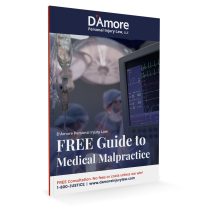D'Amore Personal Injury Law, LLC
Serious Injury Lawyers Proudly Serving
Baltimore, Annapolis, & Washington, D.C.
Pediatric Malpractice
What is Pediatric Malpractice?
Pediatric malpractice is a general term used to describe a situation where the child’s negative medical outcome would not have occurred if the doctor(s) had acted as other reasonable doctors would have under similar circumstances. According to recent studies, a missed, failed, or wrong diagnosis from subpar medical assessments is the number one reason for medical malpractice suits involving pediatric patients.
Clients Lives We've Helped Rebuild

Common Types of Pediatric Malpractice
Meningitis
The most common malpractice claims occur from misdiagnosis of illnesses. One such illness is called meningitis. Meningitis is an infection that causes inflammation of the membranes (the meninges) covering the brain and spinal cord and can occur in different ways. Bacterial meningitis is a medical emergency that may result in brain injury or death if not diagnosed and treated. Meningitis treatment varies by type, age, and symptoms. Treatment for bacterial meningitis can be as simple as antibiotics and steroids. However, when a doctor fails to correctly diagnose and treat meningitis, the child’s health can rapidly deteriorate and cause irreversible harm.
Appendicitis
The second most common illness associated with pediatric malpractice is appendicitis. While signs of appendicitis can vary from child to child, the most common symptoms are abdominal pain that begins around the belly button and moves to the right lower side of the abdomen that worsens over time. Fever, nausea, loss of appetite, and diarrhea often accompany this stomach pain. Appendicitis can be easily diagnosed through physical examinations, imaging and lab testing. However, according to the American Academy for Pediatrics (AAP), 27% of infants with appendicitis are misdiagnosed. When the correct treatment is not timely given, the child may develop health complications that are difficult or nearly impossible to reverse.
Medication Errors
Having a sick child is a nightmare for a parent, and having a doctor prescribe a cure is a relief. But, the wrong medication can make things terribly worse. Although the use of computerized medical data was supposed to make medication errors less common, we have seen some very concerning trends. The records are often hard to read, and the systems are not well understood by older doctors. This has partly contributed to an increase in medication errors. According to the AAP, when a medication error occurs, physicians are at fault 69% of the time, while nurses and pharmacies are responsible for 13% and 8%, respectively. In order to protect your child from these types of errors, you should ensure you understand the exact name and dosage of the medication your child has been prescribed. You can also reference the internet to see what the medication is supposed to look like. A very helpful website for this is Pill Identifier.
Learn about what to do after a Medical Malpractice Injury in our FREE guide.

Electronic Medical Records Errors
The adoption of EMR (Electronic Medical Record) systems was supposed to reduce medical record errors and streamline the transfer of medical information. Unfortunately, the majority of electronic health records are not equipped with functionalities to address pediatric needs. A study done by the National Institute of Health (NIH) demonstrated that the EHR systems used by many pediatric practices don’t meet the standards of the AAP. An example of this occurred in a recent case we handled at D’Amore Personal Injury Law in which an older pediatrician who was used to working with paper charts failed to recognize our clients abnormal head growth because of the way it was recorded in the electronic data. It was only after the child suffered permanent injury that his condition was recognized and treated. The lesson here: be very careful about ensuring your child’s doctor is comfortable and familiar with the record keeping system he/she is using.
Surgical Malpractice
Pediatric surgical errors can be some of the most devastating. The range of damage that an error during surgery can cause is widespread and can be overwhelming for a parent. Many surgeons are unfamiliar with pediatric techniques and, because many pediatric surgical cases are rare, they have little or no experience.
We recently handled a matter for a family against a major urban academic center that was supposed to have the most experienced surgeons. However, it was unknown to this family that most of the top surgeons had left the hospital to take other positions. Leaving behind a program that “looked good on paper” but was staffed by doctors with very little experience. When these surgeons tried to treat our client’s complex surgical case, they found themselves in over their heads, and our client suffered permanent, life changing injury. To avoid an outcome like this, it is critical for parents to research their child’s surgeon. If you are not comfortable with the experience level of the surgeon, find another one.
Post-Surgical Care Mismanagement
Doctors have a duty to adequately and clearly communicate with you regarding your child’s status and care. A study by The Doctors Company (the largest physician-owned medical malpractice insurer in the nation) found that poor communication between the physician and patient’s family was a factor in 15-22% of claims depending on the child’s age.
When your child has to undergo surgery, some pain afterwards is expected. But how do you know the difference between discomfort from healing and pain from mismanagement? Because children often cannot fully verbalize their feelings and symptoms, their medical staff are expected to know how to recognize and assess their pain. Post operative care can include monitoring vital signs and values, preventing infection, managing wound care, and assessing fluids. System failures, such as lack of staff communication regarding critical test results, accounted for a significant number of patient injuries. Pediatric doctors and nurses are expected to know the abnormal values and signs to watch out for during postoperative care and explain the situation to the family. When those signs go unnoticed or untreated, an already scary situation can become life threatening.
How Common is Pediatric Malpractice?
Allegations of wrongdoing in pediatrics are fairly common. Pediatric doctors, like any other specialty doctor, can make irreversible mistakes. In fact, an earlier study by the AAP found that there were approximately 2 recorded errors among hospitalized children per every 100 discharges. Further studies by the AAP indicate that approximately one fifth of all pediatricians will be sued at some point during their career, with 58% of those claims being successful for the patients.
How Long do I Have to File a Pediatric Malpractice Case?
Every state has a unique “statute of limitations” when filing medical malpractice claims against offending healthcare providers. In Maryland, for example, state law provides victims of medical negligence up to five years after the adverse event occurred to file a lawsuit. If a patient was unaware that a mistake or some form of negligence occurred, they are given up to three years from the date of discovering that fact to file a lawsuit. Note that victims of medical malpractice under the age of 16 when injured are given more time than this to seek legal recourse under Maryland law.
However, no matter where you live in the U.S., it is essential to seek legal guidance as soon as you can if you believe that you may be a victim of medical malpractice. Scheduling risk-free consultations with medical malpractice lawyers won’t obligate you to file legal action. But, by acting quickly, your lawyer will be better able to preserve critical evidence, begin investigating the circumstances surrounding your harm, and otherwise protect your interests. As a result, you’ll be empowered to make informed choices within the statute of limitations period. You’ll have taken the time to seek personalized, professional guidance before making significant decisions about your legal situation.
What is Involved in a Pediatric Malpractice Lawsuit?
Like in any medical malpractice lawsuit, the injured person must prove negligence on behalf of the doctor. To show negligence, the plaintiff has to show that there was a duty to the patient and that the doctor failed to follow the standard of care which caused damages to the child. Damages can include developmental delays, physical impairment, pain and suffering, past or future medical expenses, and other injuries. You can find a detailed description of the process in the D’Amore Personal Injury Law Guide to Medical Negligence Claims.
Speak with a Baltimore Maryland Pediatric Malpractice Lawyer
There is nothing more tragic to a parent than the suffering or injury of their child. When a medical provider makes an error which causes your child pain, suffering, life-long illness, or even death, they need to be held responsible. Pediatric doctors can be sued the same as any other doctor. If you believe that a doctor has made a mistake, it is important to contact an experienced and successful medical malpractice lawyer in order to protect your child’s rights, and provide him/her the best chance at a safe, productive and sustainable future.
Please Contact D’Amore Personal Injury Law, LLC if you would like to discuss your child’s claim. We are available 24/7 and there is no cost to you unless we win your child’s case.
FREE Case Consultation
Fill out the form below and we will contact you.
Or, give us a call at